Tuesday, April 6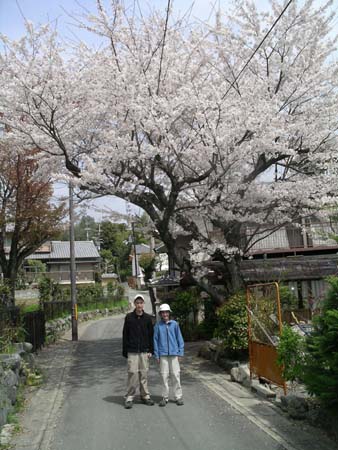
Steve: Today's plan was to explore the west side of Kyoto, and another beautiful sunny day helped make up for the washout two days ago in Nara. We had arranged to spend the day with Chris, a Connecticut native who has made his home here in Japan and is the author for Lonely Planet's Kyoto book. Given how much we rely on Lonely Planet books, this made Chris an instant celebrity in our minds.
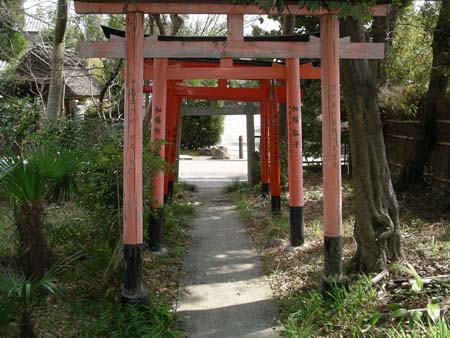 After
a taxi ride across town (this one cost us $37!), we started walking through
a quiet and very picturesque neighborhood, filled with more blossoming cherries.
Since the heart of the cherry season usually lasts for less than two weeks,
we feel extremely fortunate to have picked this particular time to be here.
The trees are really magnificent, and we have learned that Japanese from all
over the country carefully plan their vacations to match the se
After
a taxi ride across town (this one cost us $37!), we started walking through
a quiet and very picturesque neighborhood, filled with more blossoming cherries.
Since the heart of the cherry season usually lasts for less than two weeks,
we feel extremely fortunate to have picked this particular time to be here.
The trees are really magnificent, and we have learned that Japanese from all
over the country carefully plan their vacations to match the se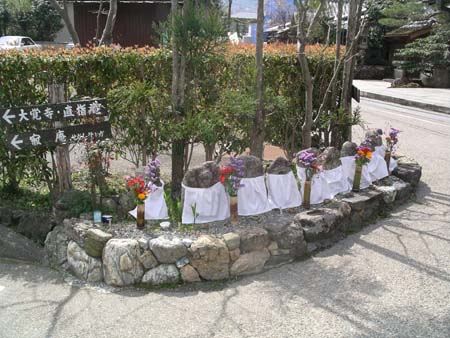 ason.
In fact, insurance is sold in case the blossoms arrive at a time other than
when people have booked their travel reservations!
ason.
In fact, insurance is sold in case the blossoms arrive at a time other than
when people have booked their travel reservations!
As we have spent more time walking in Kyoto, we've realized that a big part
of its charm comes from the shrines and temples that exist in all kinds of
tucked-away places. Of course, the popular and very beautiful religious sites
are a big draw, but we ha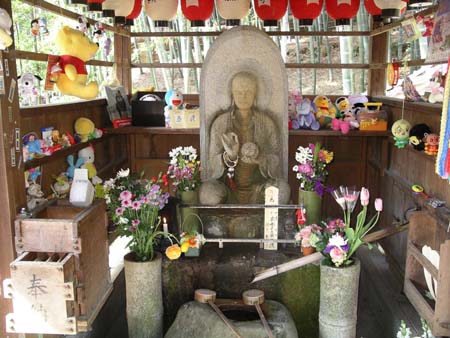 ve
actually preferred the small, lesser-known shrines and temples that represent
an important part of Japan's culture. There are thousands of these sites across
the city, and they appear hidden away in neighborhoods, on street corners,
along busy downtown boulevards, in shopping malls and in parks. Everywhere
we walk, we find very small shrines consecrated for specific deities, "jizos"
where people come to pray for unborn children and the safety of travelers
(an unusual combination), and quaint temples. At the shrin
ve
actually preferred the small, lesser-known shrines and temples that represent
an important part of Japan's culture. There are thousands of these sites across
the city, and they appear hidden away in neighborhoods, on street corners,
along busy downtown boulevards, in shopping malls and in parks. Everywhere
we walk, we find very small shrines consecrated for specific deities, "jizos"
where people come to pray for unborn children and the safety of travelers
(an unusual combination), and quaint temples. At the shrin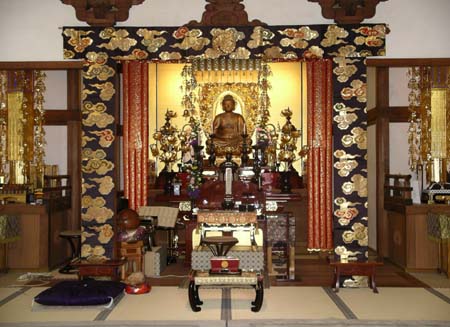 es,
we watch as people approach, perform the obligatory "coin toss",
ring the large bell, purify their hands and mouths with water, clap their
hands, bow and pray. They then abruptly leave to continue their shopping or
other daily activities.
es,
we watch as people approach, perform the obligatory "coin toss",
ring the large bell, purify their hands and mouths with water, clap their
hands, bow and pray. They then abruptly leave to continue their shopping or
other daily activities.
Japan's shrines are part of the country's official Shinto religion, dedicated
to th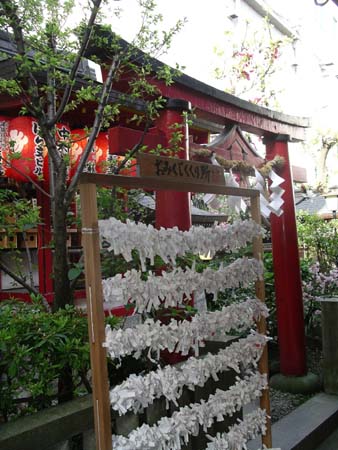 e
reverence of all things natural. There are shrines consecrated to hundreds
of deities, but the most common ones we saw were shrines for the harvest,
and the "jizos." We also saw shrines where people pray for the health
of their children, for success on exams, and for general happiness in life.
Japan's temples are associated with Buddhism, which is not recognized as an
"official" religion (as of 1868). However, Buddhist tradition and
ritual does play an important part in specific aspects of life here, particularly
for funerals.
e
reverence of all things natural. There are shrines consecrated to hundreds
of deities, but the most common ones we saw were shrines for the harvest,
and the "jizos." We also saw shrines where people pray for the health
of their children, for success on exams, and for general happiness in life.
Japan's temples are associated with Buddhism, which is not recognized as an
"official" religion (as of 1868). However, Buddhist tradition and
ritual does play an important part in specific aspects of life here, particularly
for funerals.
The Japanese are very superstitious, and are able to purchase fortunes at
the 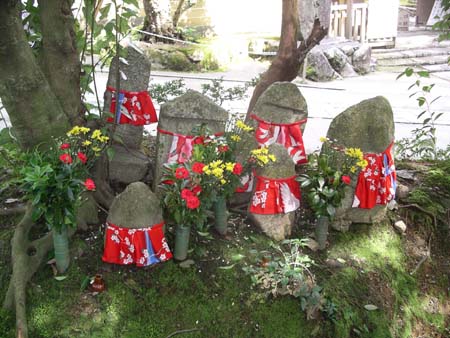 shrines.
The fortunes can be one of four categories, ranging from very good to very
bad. The best fortunes are taken home and savored. The worst fortunes are
hung on a tree or special rack near the shrine, in the hopes that the deities
will take action to remove the upcoming bad luck. We chose not to purchase
any fortunes, the thought process being that if bad luck is coming, we'd rather
not know (a typically practical way of thinking for us)!
shrines.
The fortunes can be one of four categories, ranging from very good to very
bad. The best fortunes are taken home and savored. The worst fortunes are
hung on a tree or special rack near the shrine, in the hopes that the deities
will take action to remove the upcoming bad luck. We chose not to purchase
any fortunes, the thought process being that if bad luck is coming, we'd rather
not know (a typically practical way of thinking for us)!
Many of these small shrines and temples are extremely picturesque, and seem
to blend in naturally even into settings that would normally seem very unusual.
It has been fascinating for us to observe how these play a role in the daily
lives of the Japanese people.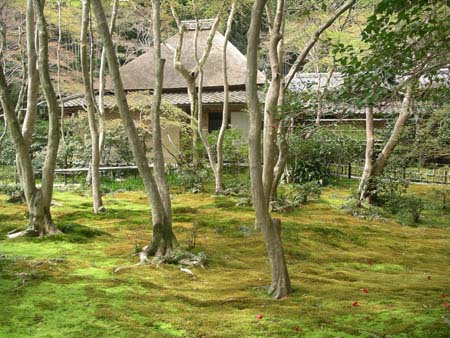
Today's walk took us through several quiet neighborhoods, and we stopped
at some specific shrines and temples. We decided to cut down on the number
of these stops today, especially given the large number of places we visited
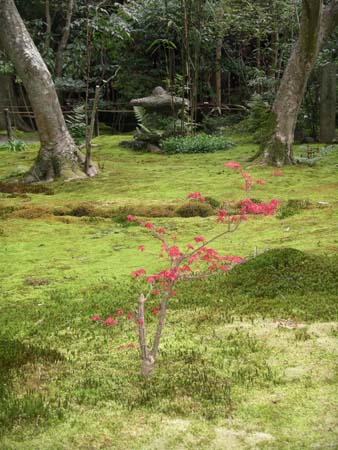 yesterday.
However, there were a few destinations that were very special, including the
Ghi-ohji temple which is set beautifully in a moss garden and surrounded by
beautiful trees. On one side of the temple is a wonderful forest of bamboo
trees with thick, smooth and very green trunks. The bamboo here has been culled
so that the trees grow to be extremely tall (as opposed to the bush-like bamboo
that w
yesterday.
However, there were a few destinations that were very special, including the
Ghi-ohji temple which is set beautifully in a moss garden and surrounded by
beautiful trees. On one side of the temple is a wonderful forest of bamboo
trees with thick, smooth and very green trunks. The bamboo here has been culled
so that the trees grow to be extremely tall (as opposed to the bush-like bamboo
that w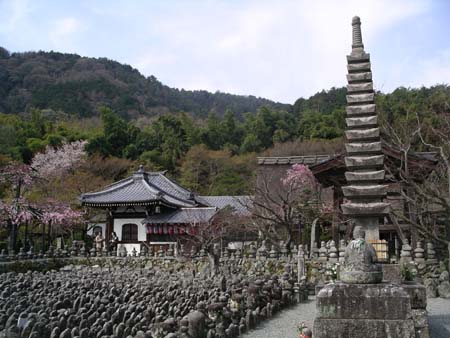 e've
seen elsewhere in Asia). The temple blends in beautifully, and is wonderfully
peaceful. It was great to simply spend time here relaxing, speaking with Chris,
and admiring the setting.
e've
seen elsewhere in Asia). The temple blends in beautifully, and is wonderfully
peaceful. It was great to simply spend time here relaxing, speaking with Chris,
and admiring the setting.
Similarly, the Nembutsu-ji temple was a very peaceful and beautiful stop
for us this morning. It is surrounded by over 8,00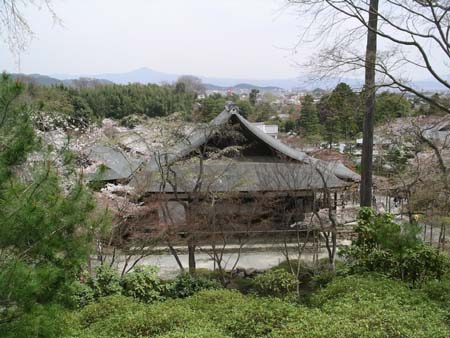 0
small stone Buddhas, some dressed with small aprons that people bring as part
of their prayer rituals.
0
small stone Buddhas, some dressed with small aprons that people bring as part
of their prayer rituals.
Another interesting stop was at the Tenryu-ji temple. This is a Zen Buddhist
temple, and is a spot that is much more popular with Japanese tourists, largely
due to its beautiful gardens and ponds. The temple also provides great views
of Kyoto and the various surrounding mountains and hills. The approach to
the temple is a long path that cuts through a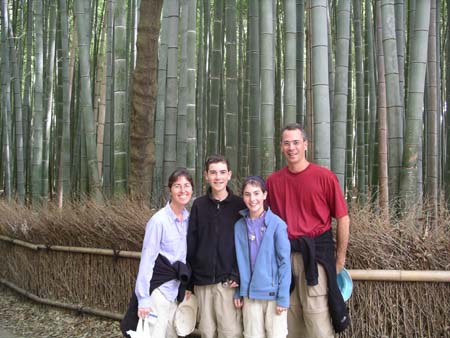 nother
spectacular bamboo forest. It was along here that David announced we had reached
the exact halfway point of this part of our trip. Since January 9, we have
traveled for exactly 88 ½ days, with another 88 ½ to go. David
determined that we reached this point precisely at Noon today, and we took
this family picture at the exact moment to commemorate this very important
milestone!
nother
spectacular bamboo forest. It was along here that David announced we had reached
the exact halfway point of this part of our trip. Since January 9, we have
traveled for exactly 88 ½ days, with another 88 ½ to go. David
determined that we reached this point precisely at Noon today, and we took
this family picture at the exact moment to commemorate this very important
milestone!
We walked through the area of Arashiyama in Kyoto's west side. 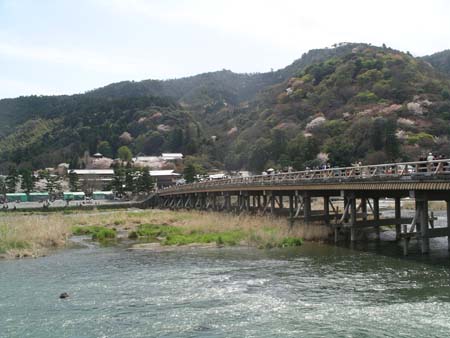 This
whole area is packed with tourists, again due to the cherry blossom season.
We stopped to view the Togetso-kyo Bridge, framed by picturesque hills with
traditional Japanese homes and several blooming cherry trees. Chris told us
that this is the most photographed spot in all of Kyoto, so we
This
whole area is packed with tourists, again due to the cherry blossom season.
We stopped to view the Togetso-kyo Bridge, framed by picturesque hills with
traditional Japanese homes and several blooming cherry trees. Chris told us
that this is the most photographed spot in all of Kyoto, so we 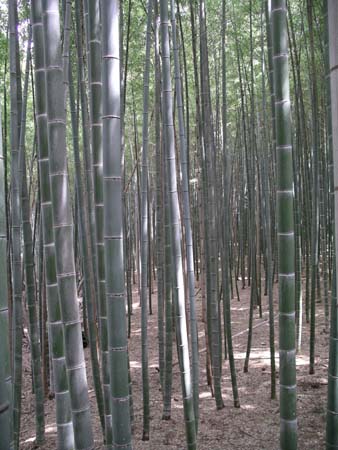 of
course had to take our own pictures. In recent years, the area has become
highly developed and is not as pretty as it once was, but is very nice.
of
course had to take our own pictures. In recent years, the area has become
highly developed and is not as pretty as it once was, but is very nice.
For lunch we picnicked along the river, enjoying "bento boxes"
which are compartmentalized meals containing fish, rice and various vegetables.
It was nice to spend time relaxing in today's warm weather, and watching the
various boats and activities along the waterfront. We always enjoy watching
all 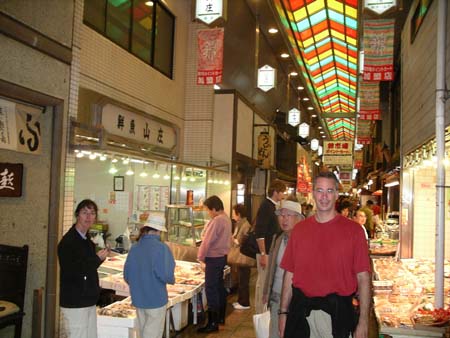 varieties
of small dogs being walked by the Japanese, usually with cute little sweaters
or shirts. Dogs are very popular here, but most seem to be bred to be loyal
only to their owners (I found this out when a small, cute creature almost
took my hand off!).
varieties
of small dogs being walked by the Japanese, usually with cute little sweaters
or shirts. Dogs are very popular here, but most seem to be bred to be loyal
only to their owners (I found this out when a small, cute creature almost
took my hand off!).
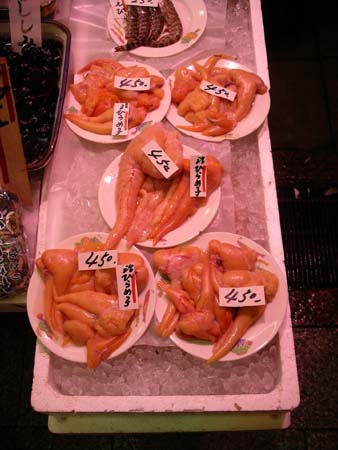 Our
final stop of the day was in downtown Kyoto where we thoroughly enjoyed a
walk through the Nishiki food market. This is a long, covered market containing
a huge variety of specialty foods that the Japanese use in their cooking.
The food is very expensive, and people generally can afford to come here only
on occasion.
Our
final stop of the day was in downtown Kyoto where we thoroughly enjoyed a
walk through the Nishiki food market. This is a long, covered market containing
a huge variety of specialty foods that the Japanese use in their cooking.
The food is very expensive, and people generally can afford to come here only
on occasion. 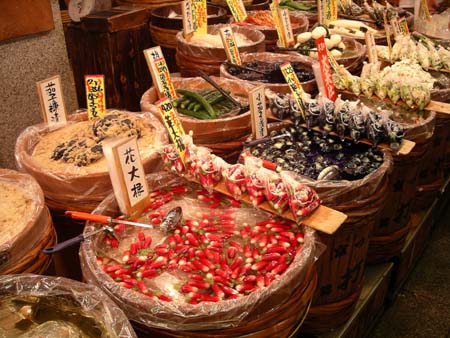 Most
of what we saw consisted of various types of seafood, seaweed, pickled vegetables
and Japanese sweets. Very interesting were the specific parts of the fish
that are sold - we saw grilled eel liver, fresh egg sacks, and even "fish
testicles" (brought back memories of the goat "cock and testicle"
signs in China!) being sold. Chris told us that the Japanese like to make
a sport of getting foreigners to
Most
of what we saw consisted of various types of seafood, seaweed, pickled vegetables
and Japanese sweets. Very interesting were the specific parts of the fish
that are sold - we saw grilled eel liver, fresh egg sacks, and even "fish
testicles" (brought back memories of the goat "cock and testicle"
signs in China!) being sold. Chris told us that the Japanese like to make
a sport of getting foreigners to 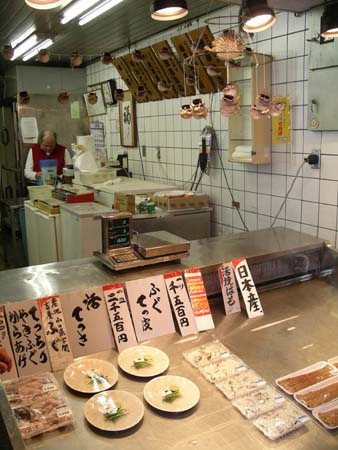 eat
unusual foods, and he had recently partaken in eating some of the testicles.
Some of the fish is eaten live, and Chris described how the Japanese like
to eat octopus tentacles that are still moving, allowing them to feel the
suction cups working on the tongue. We think we'll try that tomorrow night!
eat
unusual foods, and he had recently partaken in eating some of the testicles.
Some of the fish is eaten live, and Chris described how the Japanese like
to eat octopus tentacles that are still moving, allowing them to feel the
suction cups working on the tongue. We think we'll try that tomorrow night!
One entire store (pictured on the left) is dedicated to selling raw "fugu
fish" - this is what we call puffer fish, and it's eaten as sushi. This
is considered a delicacy, but only certain stores and restaurants are licensed
to prepare fugu fish. The fish can have a very lethal poison in its liver,
and Chris told us that a few people die each 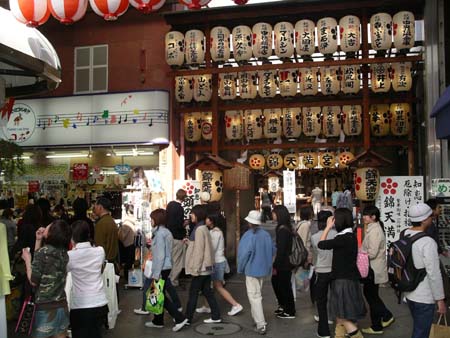 year
from fish that has not been properly prepared. We decided to pass…
year
from fish that has not been properly prepared. We decided to pass…
Nishiki market is connected to the Teramachi shopping arcade, a bustling
area that's popular with young people. Interestingly, there's a large shrine
right in the middle of the mall, wedged between a store selling sunglasses
and one selling clothes. The shrines here are somewhat commercialized, displaying
the names of sponsors who contribute money toward their maintenance. Around
the corner from the arcade, tucked in behind some smaller stores, we found
another tiny shrine dedicated toward the child of an 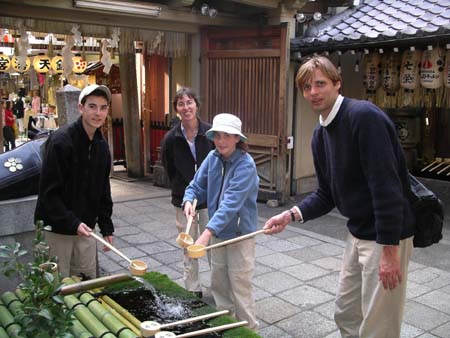 old
imperial family. Fascinating!
old
imperial family. Fascinating!
Our final walk of the day took us along Teramachi Street, which contains several very interesting craft and antique stores. We plan on returning here when we have more free time.
For dinner tonight, we enjoyed "Yakitori", which is Japanese shish-kebab. We sat at a large horseshoe-shaped bar, and watched as a variety of meats, vegetables and seafood was expertly grilled and served. Our favorites were the squid and octopus. Many of Japan's restaurants are built around open cooking areas such as this, and it's fun to watch the employees all greet people with loud Japanese welcomes as they arrive (they also do the same thing to say goodbye when people leave).
Tomorrow is our last day in Kyoto, and we plan to spend a leisurely day doing
some additional exploring, walking and shopping. This is a very special place,
and has been a wonderful contrast to our experience in the big city of Tokyo.
We feel very fortunate to have been able to see Kyoto in its greatest beauty,
at the peak of cherry blossom season. Although this has also meant large crowds
in some places, on balance it's been worth it.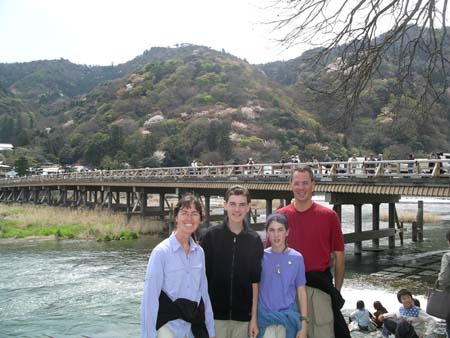
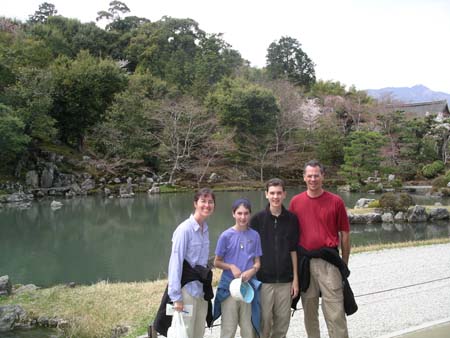
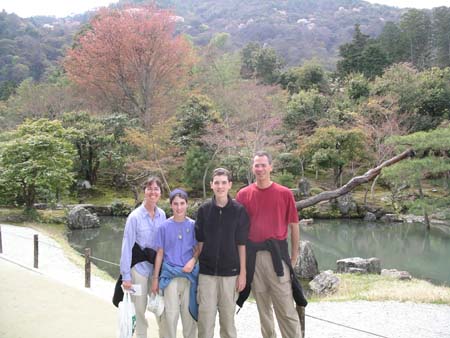
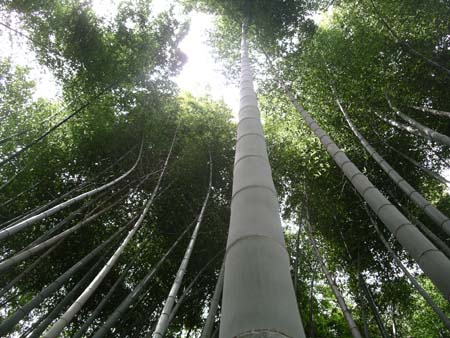
As a final note for today's entry, we forgot yesterday to mention a somewhat unique establishment that we saw yesterday. Apparently, there are over 25,000 "Love Hotels" in Japan, and we happened to walk through one of these areas yesterday. When we said we had never heard of such a thing, Ian took us inside one so we could see what this was all about. As its name implies, a Love Hotel is a place where couples rent rooms by the hour. The lobbies consist of electronic boards with lit pictures of rooms that are currently available. You simply survey the current selection, pick the room you want, push the appropriate button, and out pops the key. Then the light on the picture goes out to show that the room is now unavailable. In case all the rooms are "occupied", there are small private waiting areas complete with couches and private televisions. The parking lots contain special shields that people place in front of their license plates, in case a spouse or other acquaintance happens to walk by. What creativity!
